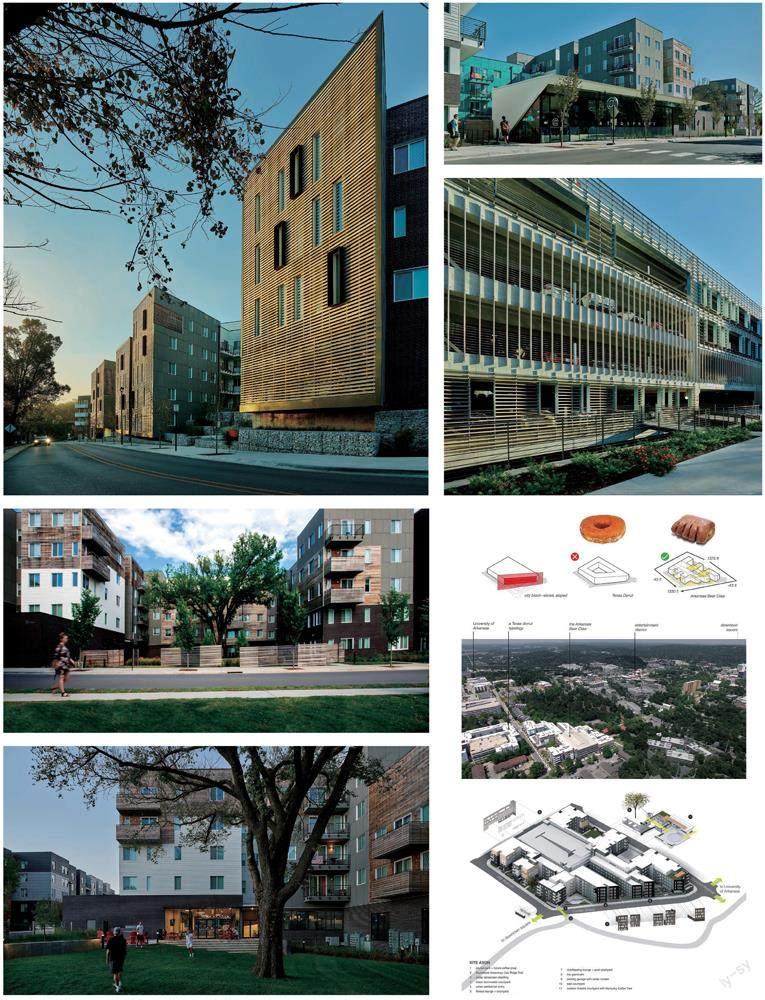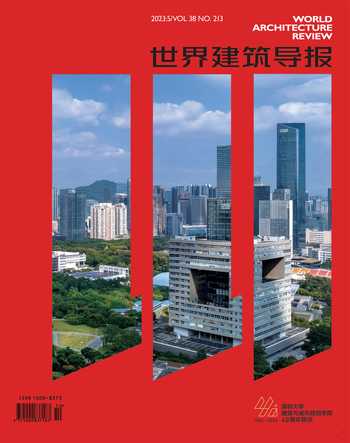阿肯色熊爪多功能综合体Arkansas Bear Claw



设计单位:modus 建筑工作室
设计团队:Chris Baribeau(主创建筑师),Aaron
Speaks(项目主管),David McElyea, Graham Patterson, Assoc. Suzana Annable, Leanne Baribeau, Philip Rusk, Assoc. Cory Amos, Michael Pope
施工单位:特立尼塔斯建筑公司
景观设计:生态设计集团公司
机电工程:HP工程公司
土木工程:麦克莱兰顾问工程公司
结构工程:SCA顾问工程公司
建筑面积:325 233平方米
项目年份:2017年
摄影:Timothy Hursley
Architects: modus studio
Lead Architects: Chris Baribeau, AIA (principal architect); Aaron Speaks, AIA (project manager); David McElyea; Graham Patterson, Assoc. AIA; Suzana Annable, AIA; Leanne Baribeau, AIA; Philip Rusk, Assoc. AIA; Cory Amos, AIA; Michael Pope, AIA
Contractor: Trinitas Construction
Landscape Architect: Ecological Design Group
MEP Engineer: HP Engineering
Structural Engineer: SCA Consulting Engineers
Civil Engineer: McClelland Consulting Engineers
Area: 325 233 m?
Year: 2017
Photographs:Timothy Hursley
该项目位于美国阿肯色州费耶特维尔的城市中心,毗邻阿肯色大学,建筑项目地块较为复杂,其中包含有多种功能。建筑沿地形边界而建,有着锯齿状几何形体量,这种设计呼应了山地的特征,同时形成独特的建筑形式。这些当地特征让建筑相较于传统的环形学生项目有着鲜明的对比,建筑师称这些建筑为“德克萨斯甜甜圈”,他们认为,阿肯色州熊爪综合体项目更适应于此类密集型居住模式。
“甜甜圈”的环形空间非常简单易懂,同时满足标准化模式尺度,中央形成院落,日光穿过表皮进入内部。而熊爪空间则完全不同,其空间的适宜和立面的美感来源于自然形态,每个空间都有着日光照射,因此有着较为丰富的采光效果。体量与体量之间的空地则形成户外庭院,在这里,建筑呼应地形,场地和使用者和谐相处。
该项目包含有628间卧室和228个单元,而有层次的砖石面板、自然风化的雪松幕墙和百叶、纤维混凝土板和钢材,共同构成这座建筑的材质体系。建筑的侧翼体量环绕着原有树木和中央休息场所。使用者的俱乐部会所位于中央体块之中,由玻璃围合而成,让使用者能够欣赏到街道与院落的景观。折线形屋面覆盖着建筑的入口,同时为人们带来能够共享室内外空间的场所。
相比起传统“甜甜圈”模式的大片沿街圍墙,而熊爪模式则为人们带来了独特的街道空间体验,建筑师将建筑体量嵌入费耶特维尔山坡,同时运用铰接的形式让建筑和城市和谐共生。
This student focused multifamily project occupies a complex Ozark site adjacent to the University of Arkansas in Downtown Fayetteville. Extensive site topography defines the building characteristics in stepping massive forms and angular geometries that are the resultant of Center Street diagonally slicing the hillside, which creates an unusual trapezoidal block. These native characteristics drove the architectural concepts and delivered in built form a stark contrast to the most normative of all student-housing typologies: the Texas Donut. We argue that the Arkansas Bear Claw is a more adept model of dense multifamily living.
The donut is a simple typological form, easily understood, capable of delivering standard industry building widths, often-benign courtyards, and some daylight via a too-sugary skin. The bear claw, with its cinnamon goodness and proportionally correct sweet veil, is form-driven with natural pockets of space, allowing ample and varied daylighting experiences. The courtyards between building wings are extraverted engageable spaces capable of playing with topography, pedestrians, and drivers alike.
A layered palette of brick, naturally weathering cedar screens and siding, fiber cement board, and steel composes massive areas of dense five-story apartment construction containing 628 bedrooms and 228 units. The wings of the building are focused around preserved specimen trees and programmed community amenity spaces. The tenant clubhouse is counter-intuitively located mid-block, a glass box that provides a transparent threshold between the street and the pool courtyard. The origami roof form captures the entry and provides a roof deck that gives tenants the outdoor opportunity to straddle the public and private realm.
In lieu of an unforgiving massive donut wall along the street, the formal carving of the Arkansas Bear Claw presents a uniquely scaled street experience that is at once an inviting urban rhythm and articulated building form along the Fayetteville hillside.

